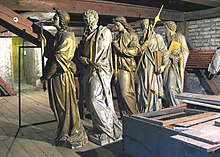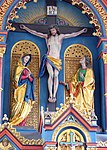Josef Beyrer
Josef Beyrer (born December 24, 1839 in Lermoos -Obergarten, † December 19, 1924 in Imst ) was an Austrian sculptor of the 19th century. He lived for a few years in Kaufbeuren and for a long time in Munich and Imst. His son Eduard Beyrer also gained importance as a sculptor.
Life
Josef Beyrer was baptized in Lermoos on Christmas Eve 1839, and he probably saw the light of day in the Obergarten district, where his father was a turner, on the same day. So he came into contact with wood in his father's house from early childhood.
“At the age of five, the boy dreamed of one day becoming a sculptor, and this desire grew more and more from year to year, but especially as his school years came to an end. Beyrer often had to atone for this longing: since his father was very opposed to the project for material reasons, the young art enthusiast was forbidden to draw and to cut something in wood under severe punishment. Beyrer finally ran away at the age of 13 and, with the help of a cousin, came to the then 70-year-old sculptor Franz Xaver Renn in Imst as a pupil in 1853 ... "
The three years of apprenticeship - from 1853 to 1856 - with Franz Xaver Renn in Imst were formative for Beyrer's whole life: He regarded Imst as his “second home” and returned to this city in 1898 to spend his old age there.
From 1857 to 1862 Josef Beyrer worked for his compatriot Johann Nepomuk Petz in Munich. (Petz also came from Lermoos, but was not a racing student.) At Petz, Beyrer made “many individual figures and reliefs in wood”.
Beyrer's plan to emigrate to America was not carried out because Beyrer found increasingly plentiful employment after 1862. In 1862 he and his future father-in-law, the master stonemason Johann Schwarz, founded a “studio for altar building and church restoration work” in Kaufbeuren. How the two came together is just as unknown as the exact distribution of work and competencies in the apparently rapidly flourishing company. Apparently, however, Schwarz was the boss in charge, who also settled the orders that were carried out together.
On September 30, 1865, Beyrer married the now 19-year-old daughter Maria Anna of his “partner” in Kaufbeuren. In the same year, the young couple moved to Munich, where Beyrer set up his own studio at Karlstrasse 38 (but the apartment was at Marsstrasse 40). Beyrer ran this studio with great success for 33 years. He declined appointments to the art schools in Nuremberg in 1866 and Innsbruck in 1868, referring to his many commissions, but also because he did not want to leave Munich. From the very beginning, Beyrer also employed people in Munich - initially his younger brother Heinrich, and later also his son Eduard. The sculptors Georg Rauscher and Franz Uhl are also named as helpers.
Why Beyrer, not yet 60 years old, left Munich in 1898 and went to Imst “as a pensioner” is one of the unanswered questions as well as the progress of his marriage. Did his wife die in Munich before he left - or did they even split up? In any case, it is strange that Beyrer apparently spent his 60th birthday in England, where he dedicated a drawing to his “loyal friend Johanna von Neuner”.
The Reutten historian Richard Lipp reports that Beyrer left Munich because of "cheap competition" and that a persistent stomach ailment prevented him from practicing his art. Apparently Beyrer continued to work after his return to Imst, albeit on a more modest scale. The fact that Beyrer "spent his old age in extreme poverty in Imst" must be doubted in this generalization. The bills alone in the parish archives of Heilig-Kreuz in Munich-Giesing and St. Georg in Augsburg testify to Beyrer's high income in his last years in Munich. What is credible, however, is the loss of his “modest fortune” due to the devaluation of money during high inflation . At the end of his life, the once successful sculptor was indeed dependent on the charity of others. On December 19, 1924, shortly before his 85th birthday, Josef Beyrer died of a stroke.
plant
The training by Renn shows up again and again in Beyrer's later work in small but telltale details. Probably as a thank you to his teacher, he wrote his “racing history” in 1923. The apprentice Josef Beyrer had his first encounter with the blossoming art of the Nazarenes in Imst .
Although he was not his student, neither in the studio nor at the Munich Academy, Josef Beyrer was "soon completely influenced by Josef Knabl ". Knabl was also a student of Franz Xaver Renn (apprenticeship from 1834 to 1837). From 1862/63 he held the professorship for church sculpture at the Munich Academy.
Beyrer was a perfect, almost virtuoso sculptor. The number of works he created and those still preserved is impressive, although many works fell victim to destruction, especially in the fifties and sixties of the last century, when "the Nazarenes" and all ecclesiastical art of the 19th century were viewed as inferior. Beyrer mostly used wood as a material, but he could also do stone work himself. Of course, he mostly left the latter to his employees and only made the drafts. As a rule, Beyrer signed his own works, ligating the J of his first name with the B of his surname. Initially this was done in a carefully notched script, in later years he used "Gothic" (= broken) characters.
The works of Josef Beyrer found the main distribution in Swabia. But also in the rest of Bavaria and Germany works by him can be proven. He even delivered individual works to France, England and Switzerland.
Like all of the “historicist” art of the 19th century, Beyrer's work also experienced very different levels of appreciation and assessment over the course of time. A first appreciation appeared shortly after his death.
The museum in the Ballhaus in Imst keeps a total of 29 sheets from Beyrer's estate (dating to 1901).
List of works
The following list of works is very incomplete and incomplete for several reasons. There are missing z. B. all work that Beyrer is said to have already carried out during the five years at Johann Petz . Even if Beyrer's works were well documented during his lifetime, these lists are by no means complete. Finally, the large number of known works requires a strict restriction to the most important and interesting examples.
- From 1862: Ebersbach (Ostallgäu), St. Ulrich parish church: parts of the rich figurative equipment under the guidance of Johann Schwarz (equipment completely preserved)
- From 1862 (until 1882): Zaisertshofen (Unterallgäu), parish church St. Silvester: Complete neo-Romanesque furnishings, executed together with Johann Schwarz according to a design by Ludwig Leybold (removed in 1954; the figure of the church patron and the cross group have been preserved, the latter now in the cemetery chapel )
- From 1864: Lauchdorf (Ostallgäu), Parish Church of the Assumption of Mary: high altar figures (altar by Schwarz, preserved with changes)
- 1865: Mindelheim (Unterallgäu), St. Stephan parish church: wooden figures (signed Madonna placed in the church)
- 1866: Eurishofen (Ostallgäu), parish church of St. Dionysius Areopagita: figures and reliefs (altars by Schwarz, smashed in 1952; reliefs have been preserved)
- 1866/1868: Biessenhofen -Altdorf (Ostallgäu), Parish Church of the Assumption of Mary: Extensive figurative furnishings (altars from Schwarz, removed in 1962. Only 3 figures preserved in the five-wound chapel on the Hörmanshofener Ottilienberg)
- 1870: Apfeltrang (Ostallgäu), parish church St. Michael: All figures for three altars and the pulpit (furnishings removed from 1923, fragments preserved)
- Around 1870: Kaufbeuren : stone figure of Germania as a warrior or victory memorial (executed by Uhl, preserved) and stone bust of the merchant Schrader (signed by B., preserved)
- From 1871: Mauerstetten (Ostallgäu), St. Vitus parish church : three large relief groups as a substitute for images in high baroque altars, individual figures, Mount of Olives (preserved in situ)
- From 1876: Gestratz (Lindau), parish church St. Gallus: statues and reliefs for two altars (church "purified" in 1956; Beyrer's monumental group of crosses now in the funeral hall)
- 1876–1881: Rettenbach am Auerberg , parish church St. Vitus: extensive figurative decoration in neo-Gothic altars (completely preserved)
- 1877: Eggenthal (Ostallgäu), parish church St. Afra: Rich furnishings with a dominant relief group “Death of St. Afra "in the high altar (well preserved)
- From 1877: Altenstadt (Upper Bavaria) / Weilheim-Schongau, St. Michael parish church: figurines (neo-Romanesque furnishings completely removed from 1961; several figurines came into private ownership, including the church patron, dated 1894.)
- 1878: Tutzing , monastery of the Missionary Benedictines: Stone Pietà for the grave monument of the family v. Ring ice (signed, formerly in the old cemetery)
- Around 1880: Augsburg , Cathedral of the Visitation of the Virgin Mary : 14 stations of the cross (1934 removed, now in Westheim (town of Neusäß ))
- 1881: Oberrieden (Unterallgäu), parish church St. Martin : Monumental Martinsgruppe with horse (taken over in the modern high altar; neo-Romanesque furnishings 1949/1951 completely removed, but a few figures preserved)
- From 1884: Munich -Giesing, Heilig Kreuz parish church : figure decorations of the high altar, pulpit figures, 14 stations of the cross, 12 statues of the apostles, individual figures and reliefs (works only partly by hand, but almost completely preserved; one of Beyrer's main works)
- From 1886: Augsburg, St. Georg parish church: high altar and side altar figures (including a monumental crucifixion group), 13 (!) Statues of the apostles, two candlestick angels, Pietà, Christ at rest (neo-Gothic furnishings removed from before 1954, figures only partially preserved)
- 1887: Eichstätt , Church of the Redeemer : stone relief (Christ) above the entrance
- 1892/1893: Schwabniederhofen / Weilheim-Schongau, parish church Heilig Kreuz: part of the figurative decoration in neo-Gothic altars (completely preserved)
- 1895: Kaufbeuren , parish church of St. Martin: Monumental cycle of apostles (redesigned in silver instead of color, well preserved)
- 1898: Imst , Museum im Ballhaus : Elaborate altar relief "Ave and Eva"
Fonts
- The school of Fr. Xa. Renn and its importance for plastic. Manuscript in the Imst museum depot, Imst 1923 (= racing history. )
Web links
literature
- Hyacinth Holland : Josef Beyrer. In: Julius Meyer: General Artist Lexicon. Volume 3. 2., revised edition, Leipzig 1885, p. 791 f.
- Spiritual Germany. Volume I, Leipzig / Berlin 1898, p. 50 f.
- HS: Beyrer, Joseph . In: Ulrich Thieme , Felix Becker (Hrsg.): General Lexicon of Fine Artists from Antiquity to the Present . Founded by Ulrich Thieme and Felix Becker. tape 3 : Bassano – Bickham . Wilhelm Engelmann, Leipzig 1909, p. 572 ( Textarchiv - Internet Archive ).
- Herbert Wittmann: Successfully - almost forgotten - rediscovered. Josef Beyrer (1839-1924). An Ausserferner sculptor in Imst, Kaufbeuren and Munich. In: Extra Verren 2008, yearbook of the Museum Association of the Reutte District. ISSN 1992-0261 , pp. 79-160.
Individual evidence
- ↑ The Spiritual Germany. Volume 1. pp. 50-51.
- ↑ The Spiritual Germany. Volume 1. p. 51.
- ↑ The drawing (purchased from an art dealer) is in the possession of the Reutte Museum . Beyrer's inscription on the reverse.
- ^ Friedrich Pecht: History of Munich Art in the 19th Century. Munich 1888, p. 308.
- ↑ Ignaz Philipp Dengel: In memory of the sculptor Josef Beyrer. In: Tiroler Anzeiger. January 3, 1925, No. 2.
| personal data | |
|---|---|
| SURNAME | Beyrer, Josef |
| BRIEF DESCRIPTION | Austrian sculptor |
| DATE OF BIRTH | December 24, 1839 |
| PLACE OF BIRTH | Lermoos upper garden |
| DATE OF DEATH | December 19, 1924 |
| Place of death | Imst |











